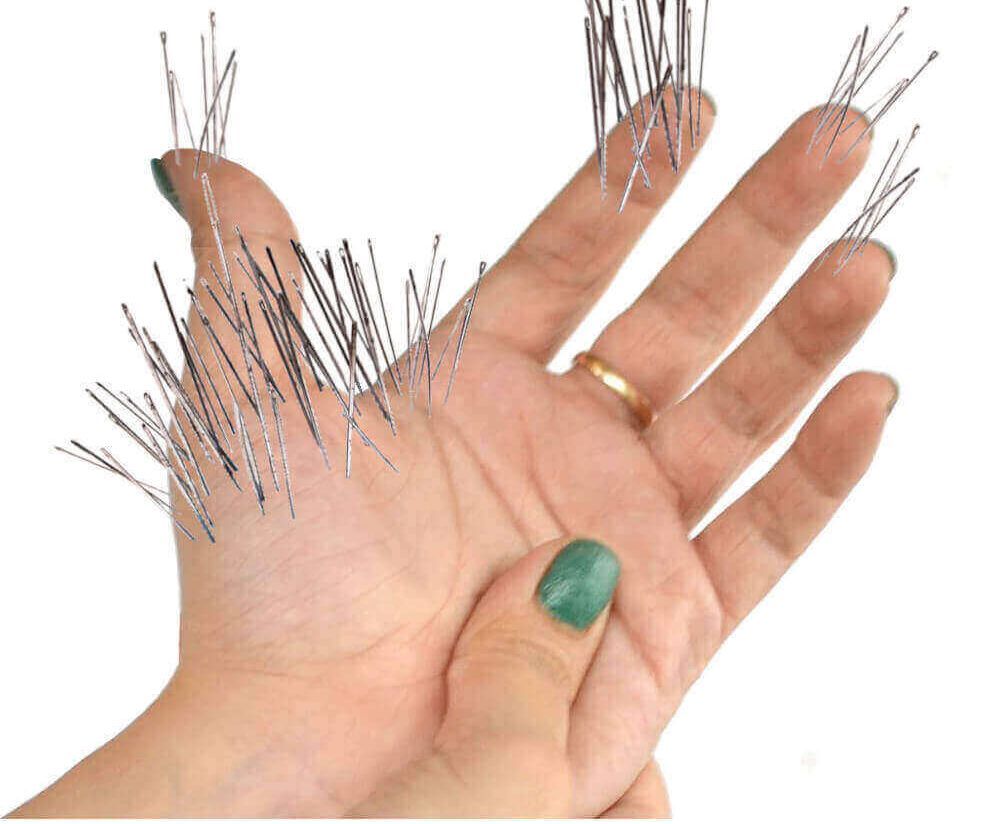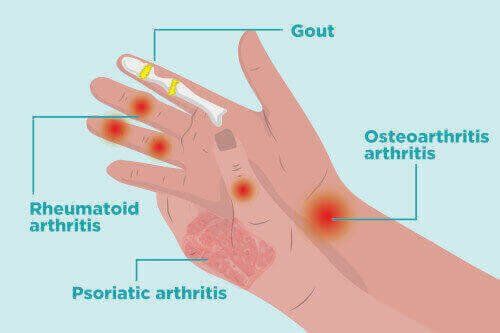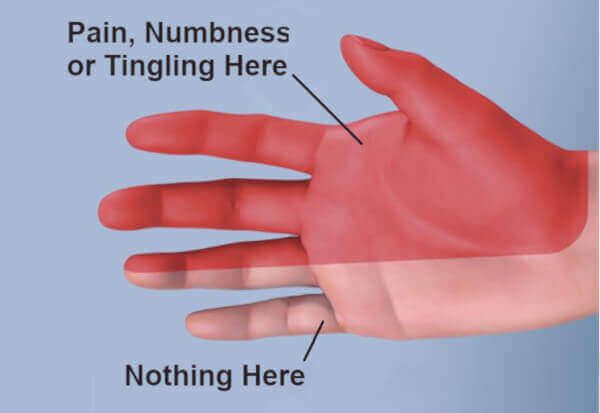Difference Between Carpal Tunnel & Arthritis
Table of Contents
- Overview
- What is carpal tunnel syndrome?
- Symptoms of carpal tunnel syndrome
- What is arthritis?
- Osteoarthritis
- Rheumatoid arthritis
- Differences between carpal tunnel & arthritis
- Summary
- FAQs
- About
Overview
Pain in the hand can be caused by one of two common problems: carpal tunnel or arthritis. Both have similar symptoms. Thus, it's important to know which you have in order to treat it.
In an aging population, arthritis is practically everywhere. Also, carpal tunnel syndrome is one of the most prevalent hand problems in the USA today. So how do you tell the difference between carpal tunnel & arthritis? This article describes what you need to know, and how to distinguish one from the other.
Note: In the early stages of rheumatoid arthritis, it’s hard to distinguish it from the
symptoms carpal tunnel syndrome without a thorough exam and a blood test.
What is carpal tunnel syndrome?
The underlying problem in
carpal tunnel syndrome is that it results from
nerve damage. It begins when the tendons inside the wrist joint inflame. As a consequence, the tendons swell with fluid and expand or bulge. That expansion pushes out and crushes all the other tissues around the tendons inside the wrist joint. One of those tissues is the
median nerve. When this nerve is squeezed or compressed it causes all of the
symptoms of carpal tunnel syndrome.
Symptoms of carpal tunnel syndrome
The symptoms of carpal tunnel occur in the fingers and hand. They include:
The thumb and first (pointer) fingers are usually most painful. But the little finger never has symptoms. Also if pain is the primary symptom, it’s usually present even when the hand is resting.
Night time symptoms are usually much worse, especially in the beginning. They cause you to wake up to shake out a
numb hand or rub painful fingers.
With carpal tunnel syndrome, hand
grip strength is usually compromised. It can affect the fingers or the entire hand. Patients also may feel their hand is clumsy or awkward. They have difficulty tying shoelaces, buttoning a shirt, or picking up coins. They constantly drop things. Finally, as the condition enters the
severe stage, sensitivity to hot and cold temperature lessens.
Having
swollen fingers or hand may or may not occur with carpal tunnel. (Arthritis, in contrast,
is
almost always associated with swelling.) However, patients with carpal tunnel often report the "feeling" of swelling or puffiness, even though the fingers and hand appear normal.
What is arthritis?
Aside from sharing similar symptoms, carpal tunnel & arthritis are both "inflammatory disorders". Carpal tunnel involves inflammation deep inside the wrist. In contrast, arthritis involved inflammation in the joints.
In fact, arthritis literally means "inflammation of the joint". It was described in ancient Greece and is the oldest known disease in mankind.
Generally, there are two main types of arthritis most prevalent in the population:
osteoarthritis
and
rheumatoid arthritis.
Other forms of arthritis include
psoriatic arthritis and
gout. They can affect the wrist, hands and fingers with pain and other symptoms.
Osteoarthritis
Osteoarthritis, the most common form, is a “wear and tear” condition. Generally, it’s associated with aging.
With damage to a joint’s
cartilage, bones can grind against each other. This will usually produce pain, and also limit your motions. Usually it occurs in the knee and hip joint.
Osteoarthritis symptoms include pain in the affected joint either during or after movement. Other symptoms include:
- Joint stiffness and tenderness
- Grating sensation as the joint moves
- Swelling and loss of flexibility
Rheumatoid arthritis
Rheumatoid arthritis or "RA" is usually the disease doctors have more difficulty diagnosing. Even experienced doctors know that carpal tunnel and arthritis have similar symptoms. So they must take extra care to correctly diagnose the condition.
Unlike osteoarthritis, rheumatoid arthritis affects the whole body. Essentially, there's a malfunction of your
body's defense mechanism against foreign invaders, like bacteria.
As a result, your body attacks your own joint tissues.
Usually it affects the joints in the hands and feet. It can also cause elbow, neck, and shoulder problems.
Generally, rheumatoid arthritis results in
tender, warm, stiff or swollen joints. A person with more advanced rheumatoid arthritis usually also has fatigue, fever, or loss of appetite. About 40% of sufferers also have symptoms in other body parts aside from their joints.
There is no single blood test or physical finding to confirm a rheumatoid arthritis diagnosis. But a
series of blood tests, X-rays, and MRI can help pinpoint the diagnosis.
Rheumatoid arthritis can be treated in several ways.
Effective medicines include immunosuppressants, NSAID drugs, and steroids. Physical therapy, stretching exercises, heat, and
lifestyle changes are also effective. Additionally, new studies suggest that
certain supplements can significantly reduce the inflammatory effects of rheumatoid arthritis.
Differences between carpal tunnel & arthritis
We've seen that carpal tunnel and arthritis share similar symptoms. Pain sensations in the wrist, hand or fingers are nearly identical -- especially in the early stages of rheumatoid arthritis. So that's when it's most difficult to diagnose.
Usually, both conditions cause throbbing or dull pain in the joints. It occurs for most of the day. Also, both conditions give you the feeling of tenderness. These symptoms even wake you up at night.
Both carpal tunnel & arthritis will give you pain symptoms. And in both conditions, pain medicines like
NSAIDs (Advil, Aleve, Motrin and Tylenol) temporarily relieve the pain.
As time goes on, the systemic effects of rheumatoid arthritis begin to happen. (Carpal tunnel will not cause those systemic symptoms.) They include
fatigue, fever, or loss of appetite.
In contrast, carpal tunnel symptoms remain in the fingers, hand, and wrist. Sometimes with carpal tunnel syndrome, the pain
shoots up the arm to the elbow.
You can perform "provocative" self-tests for carpal tunnel syndrome by
clicking here. They are composed of the Tinel, Phalen and Durkan tests. The results normally cannot be confused with arthritis.
Whether you have carpal tunnel, arthritis or even another disorder like
tendonitis, your doctor will prescribe a treatment program that's right for you.
Summary
If you have carpal tunnel, arthritis or another inflammatory disorder, severe pain is usually one of the main symptoms. In the early stages of rheumatoid arthritis it's hard to tell the difference from carpal tunnel syndrome. A
self-test can usually help determine which disorder you have.
If you have carpal tunnel syndrome, there are a number of
non-surgical treatments which work extremely well. These include
steroid shots,
myofascial release massage,
night bracing, and
stretching exercises. If you have arthritis, you should speak with your doctor. Depending on your
type of arthritis, treatments range from various kinds of
medicines to surgery.
Knowing the difference between carpal tunnel & arthritis early on is the best way to avoid long-term suffering.
FAQs
Can I get shooting electric shocks with arthritis?
You can, but it is a more common symptom of carpal tunnel syndrome.
Can I have arthritis and carpal tunnel at the same time?
Yes. In fact, RA is a risk factor for carpal tunnel, so it is common to have both.
My only symptom is joint stiffness. Which disorder can it be?
Joint stiffness is a common symptom of both arthritis and carpal tunnel. You will need more testing to determine which disorder you have.
About







